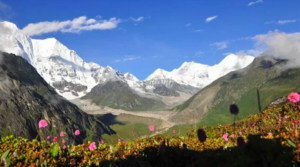While the predominant view of the natural world and global environmental discourse stems from a western neoliberal legacy, the indigenous views of nature is set in a polemic opposition of this mainstream narrative. Simply, the indigenous view holds nature as sacred and the idea of ownership over the natural world as alien. All around the world, communities have held onto the belief of the nature as sacred, constructing cosmologies of beliefs and knowledge based upon those beliefs while worshiping and guarding their natural surroundings from extraction and degradation.

Source: https://www.tibettravel.org/trekking-tibet/gama-valley.html
However, the use of indigeneity as a term, concept, and practice by indigenous communities to resist the mainstream narrative emerged from the very neoliberal institutions like the World Commission on Environment and Development and the Rio Earth Summit; these global environmental discourses set the precedence for the environmental framework to transition towards sustainable development and emphasizing the key roles of the indigenous communities and indigenous knowledge. Indignity articulates the historically and geographically situated experiences of dispossession and assimilation of peoples into modern societies due primarily to the colonial enterprise. Since the 1990s, indigenous communities have used the term indigeneity as a way of constructing their political identity to assert claims to land and resources while emphasizing their self-determination and self-representation—to that end, indigenous communities have instrumentalized the environmental stewardship and collective land titling to reclaim their political identity.
However, juxtaposing the indigenous view as an alternative to the mainstream view has limitations such as reducing complex and diverse views of nature into simplistic concepts. The indigenous view of the natural world also has a tendency to group the great diversity of views from multitude of diverse indigenous and local communities into one representative monolithic view. Furthermore, the discourse on indigenous views of nature runs into the danger of romanticizing the ‘noble savage other’ and any indigenous practice or views that runs opposite it as an existential threat. However, despite the limitations, indigenous environmental activism, stemming from the indigenous views, has been among the key and vocal resistance movements against the environmentally extractive practices of states and industries.

Source: https://tibet.net/landslide-in-gyama-mine-natural-or-man-made/#
The clash between indigenous and the mainstream narrative of the natural world can be seen in the Gyama Valley in the Tibetan Plateau. The valley is site of the sacred Tibetan mountains which are revered by the local Tibetan communities; Gyama valley is a revered site in Tibetan Buddhism as it is the birthplace of the first Tibetan Dharma King Sontsen Gampo. Pilgrims, monastic communities, and locals pay homage to the Gyama valley’s holy mountains, caves and shrines when they visit. As a sacred site, the Gyama valley for hundreds of years has been a protected area that relies on local Buddhist institutions for its conservation; while deforestation rates have tripled in neighboring non-sacred landscapes, the Gyama valley continues to be protected. However, the China Gold International Resource Corporation, a unit of the state-owned China National Gold Group, bought mining rights to the Gyama valley for gold extraction. While the local Tibetan resistance against the environmental degradation and pollution through demonstrations, petitions, and destruction of mining equipment on the sacred valley have largely been ignored by the state, it was not until 2013 when the Gyama gold mines collapsed with 83 miners dead – 2 of whom were Tibetans, making international headlines, that the global community became aware of the conflict in the sacred valley. The government applauded the economic development brought by the gold mining:
“A Mining Miracle” that said “the scene has been transformed, replaced with a panorama of lush green trees and grasslands, new roads and infrastructure, and cleaner mining facilities, giving the local people a better life” (Xinhua News August, 2013).
However, the growing frustrations of local Tibetans who have been displaced from the valley due to the mines, combined with the low unemployment and lack of overall economic opportunities, have led to the increasing trend of self-immolating as resistance of the last resort. Since 2009, 154 Tibetan self-immolations have occurred. While the context of Tibet-China is more complex along the lines of internal colonialism, nevertheless the Gyama valley represents the battle of narratives in this conflict and conservation discourse and helps highlight the tensions that exist within the political ecology of resource extraction.
By: Tsering Lhamo
____
References:
Laird, S. A. (2004). Trees, forests and sacred groves. The overstory book: cultivating connections with trees,, 30-34.
Shen, X., Li, S., Wang, D., & Lu, Z. (2015). Viable contribution of Tibetan sacred mountains in southwestern China to forest conservation. Conservation Biology, 29 (6), 1518-1526.
Wong, E. (2013, April 2). Fatal Landslide Draws Attention to the Toll of Mining on Tibet. Retrieved December 1, 2019, from https://www.nytimes.com/2013/04/03/world/asia/deadly-tibetan-landslide-draws-attention-to-mining.html.
Yeh, E., & Bryan, J. (2015). Indigeneity. The Routledge Handbook of Political Ecology, 531-539.